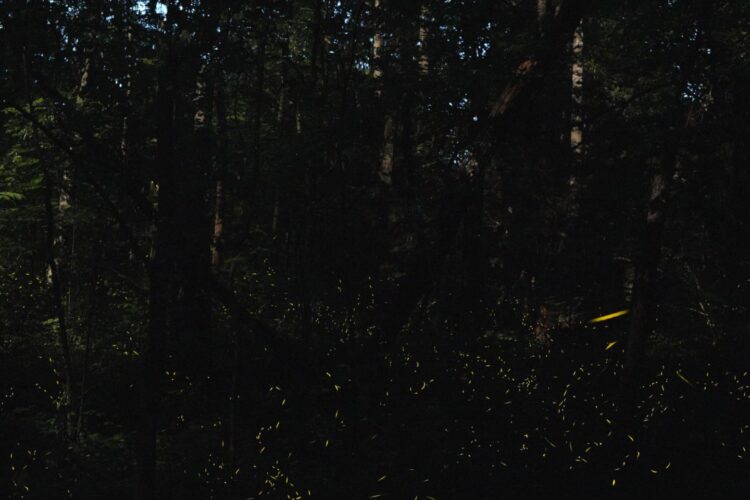
Credit: Peleg Lab
During typical summers in the southeastern U.S., streams of visitors travel to Great Smoky Mountains National Park to witness one of nature’s most spectacular displays of light: thousands of male fireflies, all flashing together in near-perfect harmony.
“This is the most beautiful biological phenomenon that I’ve ever witnessed,” said Orit Peleg, an assistant professor in the Department of Computer Science and BioFrontiers Institute at the University of Colorado Boulder.
In a study published today in the Journal of The Royal Society Interface, she and her lab members shed new light on this beautiful phenomenon–striving to understand how relatively simple insects manage to coordinate such feats of synchronization.
The team discovered that the light shows may be more complicated than scientists realized: Rather than flash according to some innate rhythm, the fireflies seem to observe what their neighbors are doing, then adjust their behavior to match.
Peleg’s team hopes the research will inspire citizen scientists around the world to get out and help to protect populations of these charismatic creatures. Some of these insect species, which use their glow to attract mates, have found themselves competing for attention with human sources of light.
“So many people have had positive experiences with fireflies,” said Raphaël Sarfati, lead author of the new study and a postdoctoral researcher at CU Boulder. “They’re also very fragile. Many species are on the decline around the world because there is more and more light pollution.”
One in a swarm
As Peleg describes it, the firefly display is over almost as soon as it begins. Males belonging to the species Photinus carolinus only flash for about two weeks every June, and then just for a few hours a night.
Studying them “is a constant race against time,” Peleg said.
Still, the sight is a must-see: During their mating displays, swarms of males stay low to the ground so as to better show off for females hiding in the leaf litter below. They also flash with a distinct rhythm: a few quick bursts of light followed by a several-second pause, then more bursts. In person, the display looks like a wave of light passing over the hillside.
To date, scientists have struggled to explain how this synchronization works.
“Is it something hardwired in fireflies that makes them want to synchronize?” Sarfati said. “Or is it something more context dependent, maybe based on their environment?”
To find out, the researchers drove to Great Smoky Mountains National Park in June 2019. There, they set up two 360-degree cameras in a wooded area–a new technological approach that allowed the team to map out the locations of the bugs flashing in their vicinity. The group also assembled a pop tent on site and introduced a few fireflies at a time to the isolated environment.
“It was, basically, like we were one of the fireflies in the swarm,” Sarfati said.
Follow the leader
The researchers-turned-fireflies found what they were looking for: Male P. carolinus fireflies, the team reported, don’t behave the same when they’re alone versus in a big group.
When the researchers, for example, put a single male into the pop tent all on his own, that bug would flash without a good sense of rhythm–a few bursts here, a few bursts there. Increase the number of fireflies, however, and things began to change.
“When you start putting 20 fireflies together, that’s when you start observing what you see in the wild,” Sarfati said. “You’ve got regular bursts of flashes, and they’re all synchronized.”
The fireflies, in other words, likely aren’t hardwired to flash with a particular pattern. Instead, their light displays seem to be more social. Bugs watch what their neighbors are doing and try to follow along. The group’s findings, Peleg said, could help researchers learn more about a range of other synchronous behaviors in nature–and maybe one day design swarming robots that act in tandem.
“This kind of synchrony occurs in many natural systems,” Peleg said. “The cells in our hearts all flex and contract at the same time. Neurons in our brains also synchronize.”
Firefly populations have also proved tricky for researchers to monitor in the wild, she said. Her team thinks that its 360-degree camera approach could provide a solution, perhaps allowing anyone to head out into the woods to keep an eye on their local fireflies. Peleg, at least, doesn’t want to see the glow from these insects disappear.
“There always was this last half an hour at night where we were tired and sitting in the forest, waiting for the fireflies to stop flashing,” she said. “It was the most relaxing part of this work.”
###
Other coauthors on the new study include Julie Hayes, a former post-baccalaureate student at CU Boulder, and Élie Sarfati of the Supinfogame Rubika in France.
Media Contact
Daniel Strain
[email protected]
Original Source
https:/
Related Journal Article
http://dx.





